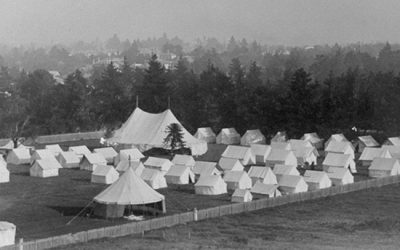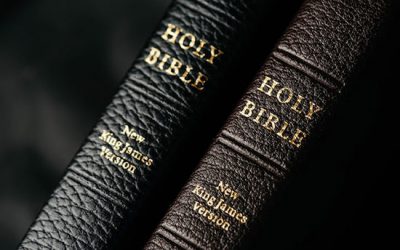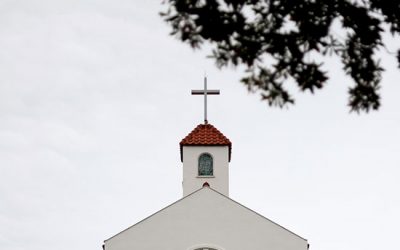The seven churches were churches that received messages from Jesus Christ through the apostle John while he was exiled on the island of Patmos. These letters are in chapters 2 and 3 of Revelation.
But beyond being literal churches in the cities of the Roman Empire, each of the churches also represents a time period of the church in history, all the way to the end times before Jesus returns.
Here, we’ll give you an overview of each church, what Jesus told the people of that church, and what period the church represents. We’ll look at:
- What the seven churches of Revelation are
- The church of Ephesus
- The church of Smyrna
- The church of Pergamum
- The church of Thyatira
- The church of Sardis
- The church of Philadelphia
- The church of Laodicea
Let’s start with what the seven churches are all about.
What the seven churches of Revelation are
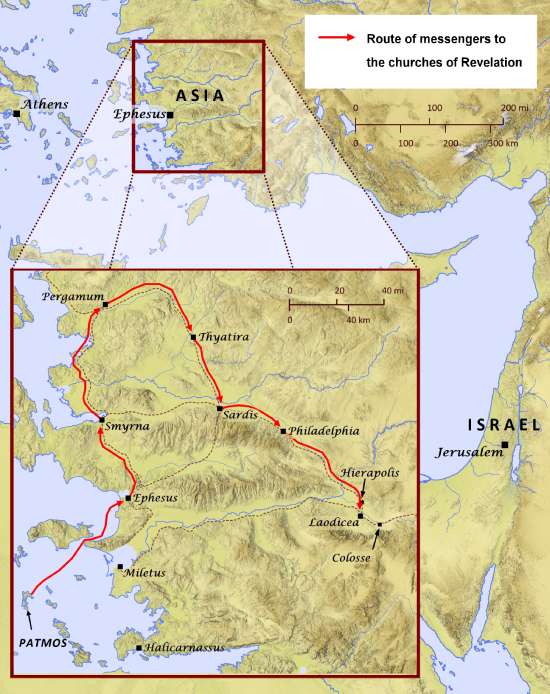 The seven churches in Revelation 2 and 3 are Ephesus, Smyrna, Pergamum, Thyatira, Sardis, Philadelphia, and Laodicea. They were all in the Roman province of Asia (modern-day Turkey).
The seven churches in Revelation 2 and 3 are Ephesus, Smyrna, Pergamum, Thyatira, Sardis, Philadelphia, and Laodicea. They were all in the Roman province of Asia (modern-day Turkey).
But these were just a few of the churches in the New Testament times. Christians worshiped in many other towns and cities around the Mediterranean, such as Philippi, Antioch, Colossae, and Rome.
Why, then, did Jesus send messages to only seven churches?
Jesus must’ve selected these churches because He knew their specific characteristics would symbolize the Christian Church during different time periods in history.
See, the book of Revelation is filled with symbols.
The seven churches are just the first of many sets of seven described in Revelation: seven Spirits, seven candlesticks, seven stars, seven lamps, seven seals, seven horns, seven eyes, seven angels, seven thunders, and seven trumpets—each one symbolic.
For example, the seven stars represent angels, and the seven lampstands represent the churches (Revelation 1:20).
And in the Bible, the number seven itself is a symbol of perfection.1
Thus, each church in Revelation 2 and 3 corresponds chronologically to a period in time, and each problem the church faced represents the problems of God’s people during that corresponding period in history.
Scholars who wrote the Seventh-day Adventist Bible Commentary point out:
“A study of history reveals that these messages are, indeed, applicable in a special way to seven periods that cover the entire history of the church.”2
But even so, these messages also apply to Christians during the various stages of their own walk with God. The messages are relevant to us, helping us be aware of things that will happen in our time (Revelation 1:1).
Let’s dig deeper into each one.
The church of Ephesus

Photo by Osama Saeed on Unsplash
The first of the seven churches is Ephesus, which means “desirable” or “lovely”—an apt description of its spiritual condition. The message to this church is in Revelation 2:1–7.
Ephesus was a powerful city, situated on the western coast of Asia Minor, and it had a Christian congregation founded by the apostle Paul (Acts 19:1–8).
These Christians worked hard to spread the good news of Jesus to those around them. Jesus congratulates them, saying,
“I know your works, your labor, your patience, and that you cannot bear those who are evil…. [A]nd you have persevered and have patience, and have labored for My name’s sake and have not become weary” (Revelation 2:2–3, NKJV).
The church of Ephesus was apparently on fire for God.
Yet it had a problem: the people had become focused on all the beneficial things they were doing and had forgotten their first love for Jesus (Revelation 2:4).
Jesus proposed a solution to help get them back on track. He told them to do three things:
- Remember their love and zeal for God and others
- Repent
- Do what they did at first
In His message to them, Jesus speaks of Himself as “He…who walks in the midst of the seven golden lampstands” (Revelation 2:1, NKJV).
This title has special relevance to Ephesus.
The lampstands alluded back to the sanctuary in the Old Testament, where the high priest would keep the lamps continually burning (Leviticus 24:1–4). Similarly, Jesus is among His church (Revelation 1:20), helping to make sure it doesn’t lose its fire and zeal.
The Ephesian church represented the early Christian age—from the first century to about A.D. 100. These Christians were definitely full of zeal. The book of Acts records many stories that illustrate their passion for Jesus.
For example, Acts 3 records Peter and John, Jesus’ disciples, healing people by God’s power.
And when both Stephen and Paul were brought to trial for their beliefs, neither wavered, preferring stoning rather than giving up their faith (Acts 7:58–60; 14:19).
The gospel spread rapidly, helped by the travels of the apostles. Paul made four separate journeys—missionary trips—around the Mediterranean, preaching and planting churches.
But even in this period, God’s people were at risk of allowing their fervor to die. Only by keeping their focus on Jesus and continuing to walk by faith would they hold onto that deep-seated fervor for God.
Especially when trials and persecution would become stronger.
The church of Smyrna
The message to Smyrna, the persecuted church, is in Revelation 2:8–11. It was one of the two churches that Jesus did not correct.
Instead, He commended the church for remaining strong through persecution, saying that despite their poverty, they were actually rich. This reflects Proverbs 8:10–11, which highlights the wealth that comes from knowing Jesus:
“Receive My [Jesus’] instruction, and not silver, and knowledge rather than choice gold; for wisdom is better than rubies, and all the things one may desire cannot be compared with her” (NKJV).
The name Smyrna means “sweet fragrance” or “myrrh.” Myrrh is an herb that lets out a “fragrant odor” when crushed.3
Similarly, when God’s people at this time experienced crushing persecution, their lives revealed the fragrance and love of Christ (Ephesians 5:2).
And in the midst of their persecution, Jesus had encouragement for Smyrna. He came to them as the “First and the Last, who was dead, and came to life” (Revelation 2:8, NKJV). He reminded them that He was in control of death and life.
He added,
“Do not fear any of those things which you are about to suffer. Indeed, the devil is about to throw some of you into prison, that you may be tested, and you will have tribulation ten days. Be faithful until death, and I will give you the crown of life” (Revelation 2:10, NKJV).
Ten days?
That doesn’t seem very long, but in Bible prophecy, a day stands for one year (Ezekiel 4:5–6). So, Jesus is actually telling them they’ll be persecuted for ten years.
This really happened in history. The Smyrna church prophetically stands for the post-apostolic church that existed from about A.D. 100–313. During this time, the Roman Empire persecuted Christians, imprisoning and murdering scores of them.4
The worst of it came during the tenure of the emperor Diocletian, who reigned from A.D. 303–313—a span of 10 years.5
But after persecution, the Christian church faced even greater danger. Find out about that next.
The church of Pergamum

Photo by Ricardo Cruz on Unsplash
The third church John writes to—Pergamum, or Pergamos—sat on top of a hill near two tributaries of the Caicus River. This could be why the city’s name meant “high” or “elevation.”
John addressed this church in Revelation 2:12–17. Its members had remained faithful to God, even when one of them was martyred in the city.
He did have one problem to correct them about, though: compromise.
In growing their church, the Pergamum Christians had incorporated beliefs of the pagan religions around them:
“But I have a few things against you, because you have there those who hold the doctrine of Balaam, who taught Balak to put a stumbling block before the children of Israel, to eat things sacrificed to idols, and to commit sexual immorality” (Revelation 2:14, NKJV).
Pergamum was a city saturated in idolatry. Temples to Diana, Zeus, and other gods crowded the streets.6 By incorporating pagan practices, the Christians were diluting the pure teachings of Jesus.
In His message to them, Jesus calls Himself “He who has the sharp two-edged sword” (Revelation 2:12, NKJV). The two-edged sword represents the Word of God, which is “living and powerful, and sharper than any two-edged sword” and is “a discerner of the thoughts and intents of the heart” (Hebrews 4:12, NKJV).
He asks the Pergamum Christians to “repent, or else I will come to you quickly and will fight against them with the sword of My mouth” (Revelation 2:16, NKJV).
God’s Word would be the standard of judgment for those who deliberately chose to disobey Him (Revelation 19:15, 21).
The Christian church as a whole went through a time of compromise too. It began after the time of persecution, lasting from about A.D. 313–538.
In A.D. 313, the emperor Constantine legalized Christianity and made it the official religion of Rome.7
You might think this was a good thing.
But it came at a price. To gain converts, the Church began to accept pagan practices, while the pagans joined the church to gain favors. It was a time of compromise—dilution—that led to spiritual decline and a weaker church.
The church of Thyatira
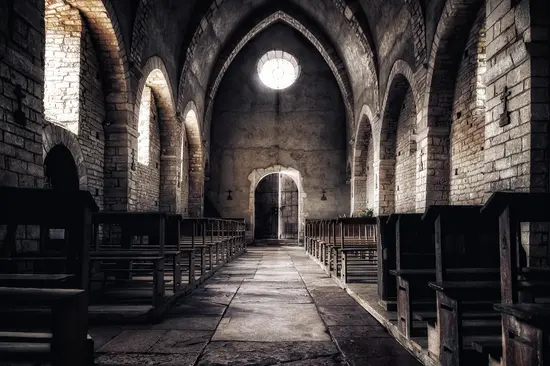
Photo from Unsplash
Thyatira was a city on the banks of the Lycus River that was known for its dyeing and indigo trade. The name Thyatira means “perfume of labor.”
Revelation 2:18–29 describes the situation of the church. They had many good attributes, like love, faith, patience, and wonderful deeds (Revelation 2:19).
But they also had some serious things they needed to work on. John wrote,
“You allow that woman Jezebel, who calls herself a prophetess, to teach and seduce My servants to commit sexual immorality and eat things sacrificed to idols. And I gave her time to repent of her sexual immorality, and she did not repent” (Revelation 2:20–21, NKJV).
This passage is clearly referring back to Jezebel, an evil queen in the Old Testament who promoted idol worship and caused God’s people to turn away from Him (1 Kings 16:29–33).
Here, she represents a corrupt church.
The symbol of a woman has been used to represent God’s people throughout the Bible (Ephesians 5:23; Revelation 19:17).
An immoral woman represents God’s people abandoning Jesus’ teachings. We find this in the book of Hosea, where God compared Hosea’s marriage to a prostitute with His relationship to His people. Prostitution illustrated the unfaithfulness of God’s people to Him (Ezekiel 23:7; Hosea 1:2; 4:10).
In His letter, Jesus says He is the “Son of God, who has eyes like a flame of fire” (Revelation 2:18, NKJV). With this title, He presents Himself as the one who is able to read hearts and execute judgment (Psalm 139:23–24; Revelation 2:23).
The church of Thyatira represents the Church during the Middle Ages. Propelled by state power, the Church held to unbiblical traditions and persecuted groups that disagreed.8
But not all within Thyatira accepted those traditions.
Jesus encouraged “the rest in Thyatira, as many as do not have this doctrine” by telling them to “hold fast what you have till I come” (Revelation 2:24–25, NKJV).
Even during this time of false teaching, some Christians remained faithful and helped turn people back to God’s Word, particularly during the Reformation.
The church of Sardis
In Revelation 3:1–6, we read of Sardis, the dead church. In name, they’re alive, but inside they’re dead.
Sardis, sitting at the base of Mount Tmolus near the river Pactolus, was an old and well-defended city. Externally, the church there appeared to be prosperous, but inwardly, the people were indifferent. The power of God was gone.
Jesus advises them to regain their close connection with God with three instructions: be watchful, hold fast to Jesus, and repent.
He tells them,
“Be watchful, and strengthen the things which remain, that are ready to die, for I have not found your works perfect before God. Remember therefore how you have received and heard; hold fast and repent. Therefore if you will not watch, I will come upon you as a thief, and you will not know what hour I come upon you” (Revelation 3:2–3, NKJV).
Jesus knew that a connection with Him was vital. He is the one who “has the seven Spirits of God and the seven stars” and could revive the spiritually dead church (Revelation 3:1, NKJV). It’s similar to the way the Holy Spirit brought life to the dry bones in Ezekiel’s vision (Ezekiel 37).
Sardis represents the time from the end of the Reformation to right before the Second Great Awakening.9
As new generations came up after the time of the Reformers, they began to stagnate in their faith. Seventh-day Adventist theologian George Burnside describes it this way:
“The reformers were men of God, but their followers, thinking that all was won, settled down to organized religion. Many became state religions supported by government funds.”10
During these years, Christians lapsed into tradition and an indifferent shell of worship as they had before.
But in the midst of this spiritual deadness, some remained true to the Bible and began revivals in the church.
The church of Philadelphia

Photo by Womanizer Toys on Unsplash
Philadelphia, which means “brotherly love,” was located along the Imperial Post Road—an important trade route—and held the only other church to receive no correction from Jesus. Revelation 3:7–13 contains the message that describes this faithful congregation.
Jesus praises them:
“For you have a little strength, have kept My word, and have not denied My name” (Revelation 3:8, NKJV).
Jesus’ name in this letter is “He who is holy, He who is true,” mirroring the Philadelphians’ earnest, unwavering faith (Revelation 3:7, NKJV). It also reveals Jesus’ role as judge (Revelation 6:10).
Despite the vast array of idols and gods in Philadelphia, the Christians there didn’t allow themselves to be distracted.
Because they were so faithful, Jesus makes this promise to them:
“Because you have kept My command to persevere, I also will keep you from the hour of trial which shall come upon the whole world, to test those who dwell on the earth” (Revelation 3:10, NKJV).
He encourages them to hold fast to Him, and those who did would have the name of God written on them.
The church of Philadelphia symbolizes the time of spiritual awakening in the late 1700s to mid-1800s. This was a time when powerful preachers and evangelists revived their congregations, studying the Bible in earnest.
The Millerite Movement, which preached the imminence of the Second Coming, took place during this time period. And the Seventh-day Adventist Church was born soon after.
The church of Laodicea
The last of the seven churches is Laodicea, discussed in Revelation 3:14–22.
Just as the meaning of Laodicea is “judging of the people,” Jesus evaluates the Laodicean church and immediately points out their problem. They weren’t dead or overly zealous in their Christian faith—just lukewarm:
“I know your works, that you are neither cold nor hot. I could wish you were cold or hot. So then, because you are lukewarm, and neither cold nor hot, I will vomit you out of My mouth…. [Y]ou say, ‘I am rich, have become wealthy, and have need of nothing’—and do not know that you are wretched, miserable, poor, blind, and naked” (Revelation 3:15–17, NKJV).
Chilling words.
The Laodicean church would have understood this metaphor of lukewarm spirituality. The city of Laodicea, located at a junction of multiple important trade routes, had a water supply full of sediment. To get clean water, they piped it from hot springs six miles away. By the time the water reached the city, it was lukewarm.11
Likewise, the Laodicean church was no longer full of the warmth of the love of God. And it didn’t realize its true condition.
To remedy this, Jesus said,
“I counsel you to buy from Me gold refined in the fire, that you may be rich; and white garments, that you may be clothed, that the shame of your nakedness may not be revealed; and anoint your eyes with eye salve, that you may see” (Revelation 3:18, NKJV).
These items were symbolic, as mentioned by the Seventh-day Adventist Bible Commentary:12
- The gold refined in the fire is Jesus’ pure truth, faith, and love (1 Peter 1:7).
- The white garments are the righteousness of God (Revelation 19:8).
- The anointing of the eyes with eye salve is the giving of spiritual discernment by the Holy Spirit (1 John 2:27).
Jesus’ title in this letter is fitting. He is “the Faithful and True Witness” (Revelation 3:14, NKJV). He faithfully told them the truth about their condition because they were caught in self-deception.
And He did so because He cared for them:
“As many as I love, I rebuke and chasten” (Revelation 3:19, NKJV).
This church characterizes the church of the end times, shortly before Jesus returns. God’s people at this time in history are living during the time of the Investigative Judgment right before the Second Coming.
Yet they’re neither religiously on fire nor spiritually dead. They are somewhere in between, thinking that they’re alright when they’re really not.
Because we’re living in the end times before Jesus’ return, we could easily fall into this lukewarmness.
But Jesus doesn’t give up on us.
He stands at the door of our hearts. He won’t force Himself in, but if we choose to let Him, He will gladly enter and make us into overcomers (Revelation 3:20–21).
The lessons of the seven churches still apply to us today
The fact that God gave messages to seven churches in the book of Revelation is significant. It is God’s perfect number, repeated throughout the Bible.
It reflects His perfect plan for history and humanity.
Even before the time periods took place, God had it all figured out—and provided the instructions, counsel, and warnings that His people would need at various times.
Though each church symbolizes a specific period of time, there are elements of each church in any given time period.
And the corrections and praises apply to our own lives and churches just as much as they did in ages past.
These messages challenge us to evaluate our own lives and allow the Holy Spirit to point out areas in which we’re struggling. At the same time, they remind us of how much Jesus cares about us and wants us to grow in Him and be prepared for His coming.
Choose an Online Bible Study
Want to keep learning? Find out more about Jesus, humanity, the plan of salvation, and how God loves you enough to sacrifice everything, just to give you a chance to choose Him.
Sometimes it can be hard to know where to start, that’s why we offer free, user-friendly, online Bible study options you can do anytime, anywhere, and at your own pace.
This online Bible school will take you through the major themes of Scripture, breaking down the Bible’s complex concepts into bite-sized pieces, which can lead you toward the answers of life’s more challenging questions.
- White, Ellen, Acts of the Apostles, pp. 585–586. [↵]
- Seventh-day Adventist Bible Commentary, vol. 7, entry for Revelation 1:11. [↵]
- Bunch, Taylor, The Seven Epistles of Christ, pp. 130–131. [↵]
- Arnold, Jack, “Church History: Persecution by the State: A.D. 60-313, Early Church History, Part 9,” Third Millennium Magazine. [↵]
- “The Great Persecution,” If Gathering.com, IF Gathering, Accessed 9 February 2023, https://www.ifgathering.com/ifequip/studies/anno-domini-i/the-great-persecution/. [↵]
- “Pergamos,” The Cyclopedia of Biblical, Theological, and Ecclesiastical Literature.[↵]
- Denova, Rebecca, “Constantine’s Conversion to Christianity,” World History Encyclopedia.[↵]
- Mark, Joshua, “Six Great Heresies of the Middle Ages,” World History Encyclopedia. [↵]
- “Sardis—The Dead Church,” Lineage Journey. [↵]
- Burnside, George, Revelation’s Wonders Unfolded, p. 53. [↵]
- Keeth, Crickett, “Laodicea—The Lukewarm Church,” Bible.org. [↵]
- Seventh-day Adventist Bible Commentary, vol. 7, p. 965. [↵]
More Answers
How Do Adventists Make Movie and Music Choices?
How do Adventists decide what music to listen to and which movies to watch? Learn how Bible principles can help us make better entertainment choices.
Does the Seventh-day Adventist Church Believe in Paying Tithe?
Seventh-day Adventists believe in paying tithe and offerings based on the biblical command and our commitment to being wise stewards of God’s resources. These donations help fund the mission of the Adventist Church by supporting pastors, missionaries, church expenses, and evangelistic projects, among other things.
Seventh-day Adventist World Population and Demographics
The Adventist Church has more than 22 million members and 100,000 churches worldwide, plus a large system of hospitals, schools, and publishing houses. Learn more about this diverse church.
What Is a Seventh-day Adventist Camp Meeting?
Although camp meetings didn’t begin with the Seventh-day Adventist Church, they’re as much an Adventist thing as haystacks.
Camp meeting is an extended event for Adventists (and non-Adventists) of all ages to gather and participate in spiritual seminars and activities. During the event, attendees often camp in tents, campers, or RVs.
How to Join the Seventh-day Adventist Church
Whether you heard about the Seventh-day Adventist Church through a traveling evangelist, during your online searches, or through a loved one or relative, you might be considering joining yourself.
How Do Adventists Do Baby Dedications?
For Christians, dedication ceremonies for babies, also for older children, are an important time for parents and the church. It’s a special part of the worship service when parents present their young children to God and the church family. Both parents, along with the congregation, regard this as a solemn promise to be a Christ-like example to the child.
Do Adventists Celebrate Communion and Foot Washing?
Like many Christian denominations, Adventists regularly participate in communion, also referred to as the “Lord’s Supper” or the “Last Supper.” They also practice foot washing (John 13:1-20), or the “ordinance of humility,” during the service—which isn’t as common.
What is the Concept of “Present Truth” and Why is it Important?
Present truth is the principle that certain biblical truths are relevant to God’s people at specific times in history. God sends the Holy Spirit to reveal truths that help us better understand how to interpret and apply His Word in a present moment.
Do Seventh-day Adventists Celebrate Easter
Yes, many Seventh-day Adventists do celebrate Easter.
Does the Adventist Church Have Youth Ministry Programs?
The Seventh-day Adventist Church has been organizing and operating youth ministry programs since 1879.
In our opinion, youth ministry is one of the most important ministries a church can have.
Do Adventists Celebrate Birthdays?
Yes, most Seventh-day Adventists do celebrate birthdays because we see them as excellent reminders of the life God has blessed us with. And we celebrate them the same way everyone else does—with friends, family, presents, and a special meal.
Sola Scriptura—What It Means and Why It Matters
Sola scriptura is a term that originated during the Protestant Reformation. It represents the way many Christians view the Bible and its authority. While the idea is simple enough, there is so much more to sola scriptura than its basic definition.
What Do Adventists Offer for Young Adults?
In recent years, the age group often classified as “young adults” has been trickier to engage. It’s been a significant concern for Christian churches around the world. Though interestingly enough, similar observations regarding young adults have been coming up in conversations about the economy, the entertainment industry, politics, and more.
Do I Need to be an Adventist to be Saved?
The answer to this question is simply, “no.”
When it comes to salvation in Jesus Christ, all that is required of a person is to acknowledge Jesus’ sacrifice for us, believe that He has saved us, and claim the free gift of salvation that is always available to us. Salvation is not based on denomination.
Do You Have to Be Vegetarian to Be Adventist?
Of course not. Membership in the Seventh-day Adventist Church has never included any dietary requirements. However, there might be some reasons people might think that. So many Adventists are vegetarians or even vegan, and a plant-based lifestyle has many health benefits.
All About Seventh-day Adventist Colporteurs
The Seventh-day Adventist Church uses a variety of methods to spread the hope of the gospel to the world. One of these ways is through colporteuring, also called “canvassing” or “literature evangelism.”
What Is an Adventist Book Center (ABC)?
When you walk into any one of the many Adventist Book Center (ABC) locations, chances are you’ll be greeted by pleasant gospel music in the background, friendly employees, and row after row of Christian books, movies, Bibles, study guides, kids’ games, and more.
Do Seventh-day Adventists Celebrate Holidays?
Wondering whether your Adventist classmate or coworker keeps the same holidays you do? Perhaps you want to include them in some festivities, but you also want to respect their beliefs. Thus, you’re unsure of how to navigate the holiday question. Will they accept your invitation to the office Christmas party?
The Adventist Haystack (It’s Not What You Think) + 4 Recipes
Haystacks are basically a taco salad—with an Adventist spin on it! Most versions are vegetarian and offer an endless combination of tasty toppings. We eat them often because they’re healthy, scrumptious, and easy to make.
Do Seventh-day Adventists Believe in Medical Care?
The Seventh-day Adventist Church believes in and supports evidence-based medical care. In fact, medicine has played a significant part in our history, and today we run a major health system with hospitals, medical schools, and clinics throughout the world.
Why do Adventists Emphasize Religious Liberty?
Adventists see religious liberty as an essential human right. After all, God endowed humanity with freedom of choice from the very beginning. So we believe it’s best for governments to also support their citizens’ rights to worship based on their convictions.
All about Adventist Elementary Schools
The Seventh-day Adventist Church operates the largest Protestant education system in the world. A big part of this system is our K-8 elementary schools, or primary schools, as they’re known in other parts of the world.
What Are Pathfinder and Adventurer Clubs?
Like the boy or girl scouts, Pathfinders and Adventurers learn about nature and life skills. But what makes these clubs special is their purpose to bring young people closer to Jesus.
13th Sabbath Offering: What It Is and Why It Matters
While the previous 12 Sabbaths of the quarter feature an established Adventist ministry and its current giving needs, the 13th is a rotating spot reserved for current mission projects.
A Look at Adventist Colleges and Universities
On the outside, Seventh-day Adventist universities may not look much different than other college campuses. But the real differences are beneath the surface.
What Is ASI (Adventist-Laymen’s Services and Industries)?
ASI, which stands for Adventist-laymen’s Services and Industries, is a membership-based organization that provides support for Seventh-day Adventist laypeople (Adventist professionals who aren’t pastors).
What Are Adventist Evangelistic Meetings?
The Seventh-day Adventist Church puts a huge emphasis on sharing the gospel through evangelism, or sharing the gospel through preaching, teaching, and testimony. One of the ways we accomplish this is by organizing public events called evangelistic meetings.
Christian Summer Camps—A Cherished Adventist Ministry
School’s out, the sun’s shining, and your kids are thrilled to have the summer ahead of them. Then three days in, you hear, “I’m bored…”
Do Adventists Have Their Own Bible?
Adventists have some unique beliefs—you might be able to name some of them right now. The seventh-day Sabbath. Death as a sleep. Hell as nonexistence.
Didn’t find your answer? Ask us!
We understand your concern of having questions but not knowing who to ask—we’ve felt it ourselves. When you’re ready to learn more about Adventists, send us a question! We know a thing or two about Adventists.






